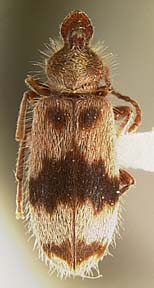
Antlike Flower Beetles
Additional images: face view (click here), ventral view (click here).
Identification:
2mm- 12mm long. This family is somewhat antlike in appearance. There are nearly 160 species in North America (Borror, et al. 1989).
The head is narrowed posteriorly to form a slender neck, and is greatly lowered with the neckline in the posterior region. The head is strongly constricted behind the eyes. The eyes are oval, small, usually coarsely faceted and emarginate (Comstock, 1920). The pronotum of some in this family has an anterior process which extends like a horn over the head. Antennae are filiform, and are not clubbed. The palps are longer and flexible. The pronotum is with rounded lateral margins (Borror, et al. 1989).
The prothorax is without notopleural sutures.
Tarsal segmentation is 5-5-4, which is distinguishing of this family. The tarsal claws are simple. The front coxal cavities are open behind (Borror, et al. 1989).
The abdomen is usally with 5 visible sterna, and the first 2 abdominal sternum are not fused (Borror, et al. 1989).
Natural History:
These insects are anthophilous, as the name implies. They are also predaceous (Comstock, 1920).
The habitat of these insects includes flowers, foliage, in ground debris and a few frequent sand dunes.
These beetles are active.
Literature Cited:
Borror, D. J., Triplehorn, C. A., and Johnson, N. F. 1989. An Introduction to the Study of Insects, 6th Edition. New York, Saunders College Publishing.
Comstock, J. H. 1920. An Introduction to Entomology. Binghamton, New York, Vail-Ballou Press.